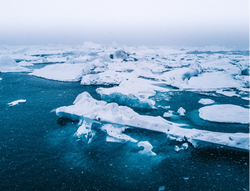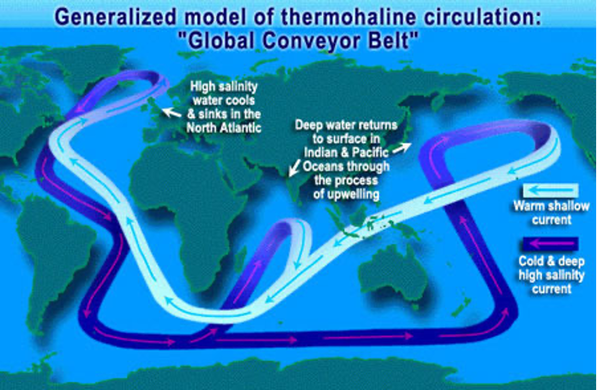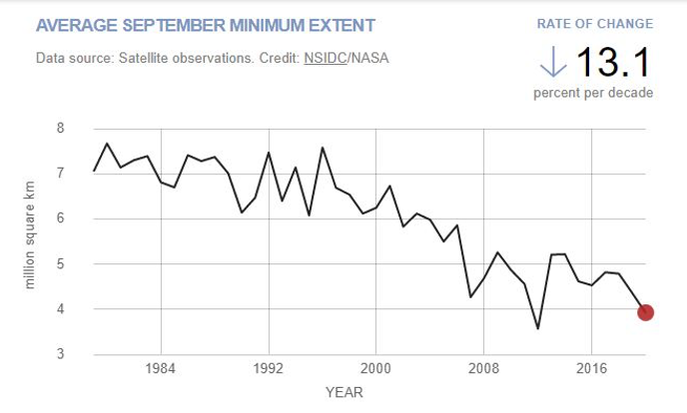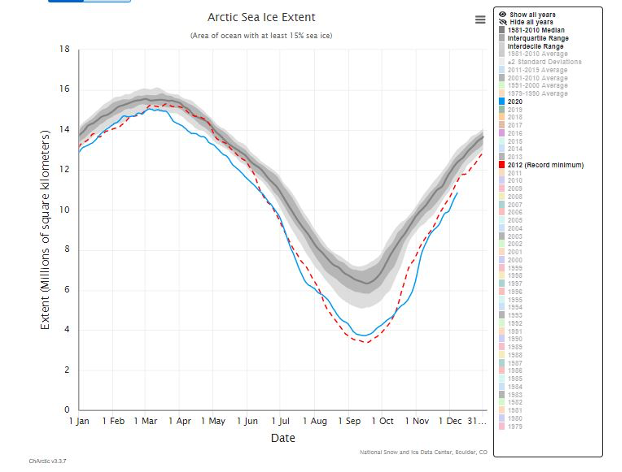 Willian Justen de Vasconcellos via Unsplash Willian Justen de Vasconcellos via Unsplash When was the first time you heard the phrase; The Arctic Is Melting? I have grown up through adulthood listening to and reading this expression. Like some climate skeptics, I also wonder, “Has it not already melted?” It was prophesied that the ice of the Arctic Ocean would disappear by 2035. But now scientists are proposing a new end mark: 2050. However, it has already lost two-thirds of its ice sheet. The icy Arctic is a climate-sensitive, fragile ecosystem. It is characterized by its ice and snow-covered land, peaks, and native wildlife including polar bears, reindeer, walruses, arctic cod, and seals. Currently, the polar natives are left with only small chunks of ice. In a few decades, the Arctic, and all its native life, will vanish. The Arctic is warming at a rate twice as fast as other parts of the globe. This rate is inconsistent with climate models and simulations. The last decade witnessed the Arctic temperature rise about 1 degree. It could surge to 4 degrees quickly if we continued at the current climate trajectory. Assuming the ice melt as a function of time does not seem right, does it? Ice-melt is a function of anthropogenic carbon emissions. Scientists believe that even if the Global Mean Temperaturerise is restrained to any value less than 2 degrees, summer ice would continue disappearing. The eventuality of Ice-free Arctic is a few decades away. POLAR SEASONAL ICE MELTSea ice is nothing but frozen ocean water. The ocean freezes into the salt-free freshwater forming frazil crystals. These crystals coalesce into pancake-like disks with featured edges/ridges along the perimeter (hence named pancake ice). These pancakes consolidate into an ice sheet, which continues to grow throughout the winters. If this ice survives the summer warming, it grows into a thick ice sheet during winter, thus called the multi-year ice or perennial ice. The sun’s rays hit Polar Regions at a slanted angle. The thick blanket of the bright Arctic ice acts like a mirror. With high albedo, ice reflects about 70% of the solar radiation into space, thus regulating the global temperature. The dark, low albedo meltwater has the maximum absorption potential for the otherwise reflected radiation. This hastens the warming of the ocean and ultimately changes the thermohaline circulations. The day when the Arctic sea ice extent (the area of the ocean with the least ice) is lowest, marks the Arctic sea ice minimum. This is usually documented at the end of the summer. The prolonged summers (March to September) with their temperature spikes result in the longer melt seasons, consequently the late sea ice minimum. The effects are evident as the Arctic is already in transition from ice and snow-dominated landscape to open waters. The ice blanket of the Arctic Ocean has been declining in its thickness and volume since the 1950s. Arctic ice used to follow a predictable cycle; maximum ice formation in March and then it retreated to a minimum extent in September. It never completely disappeared in an entire year. However, this Arctic is long gone. Ice has dramatically vanished up to 40% in the last four decades. It lost about two-thirds of its cover. Approximately 70% volume of Polar ice is now seasonal. With every ice melt in summer (July to September) and consecutive ice cover in the wintertime, the old perennial ice is superseded by thinner, younger ice. This ice is termed Seasonal Ice, which forms and shrinks within a year. The perennial ice is thicker, stronger, and more resilient than seasonal ice. The latter is more susceptible to wind patterns and atmospheric conditions than planetary warming. Thinner ice chunks can be stirred around easily. ARCTIC ICE MELT AFFECT GLOBAL CIRCULATIONSOceanic circulations maintain a temperature balance by transporting heat pole-wards. Warm water moves northwards, cools down, and sinks southwards along the bottom of the Ocean (Global Conveyer belt). As discussed earlier, sea ice is frozen freshwater or frazil. Ice formations expel salts into the ocean water, making ice fresher and the ocean water denser. The dense saline water sinks and pulls warm surface water from the south like a conveyer belt (Thermohaline circulations). The Arctic ice-melt is leading to disruptions in the thermohaline circulations. The ice meltwater is freshwater (frazil), and it stays atop the ocean and cannot sink. The fresher ocean surfaces discourage thermohaline circulations. Greenland’s meltwater is the potential hotspot of this change. RECORD-BREAKING POLAR ICE MELTThe Arctic sea-ice is very sensitive and responsive to climate. Over the decades, several studies have detailed the retreat of the Arctic ice. Some scientists study the Arctic ice-melt as a function of temperature, while others as a function of carbon emissions. One relevant study pinpoints temperature increase or warming driven by Greenhouse Gases as the lead cause. The observed linear trend for the period of 1953-2015 implies the loss of about 3 square meters of September sea-ice area per metric ton of carbon emission. September is the month with the least ice in the Ocean. September minimum ice is shrinking at a rate of 13.1 percent per decade (Source: NSIDC). At the current climate trajectory, with hundreds of Giga-tons of carbon being dumped into the atmosphere, the Ice-free Septembers will become a NEW NORMAL. As the global mean temperature is warmed by 0.85 degrees every year; the Arctic warms for about two degrees Celsius. The satellite data shows that the Arctic has already absorbed enough heat to melt it completely. The likelihood of ice-free summer explodes when the temperature increases up to 2 degrees Celsius. According to the Fifth Intergovernmental Panel on Climate Change (IPCC) report, the probability of summer ice-loss could be lessened if the planetary warming is sustained below 1.5 degrees Celsius. However, recently on September 20, 2020, United States-based National Snow and Ice Data Centre (NSIDC) reported that Arctic Sea Ice achieved its second-minimum ice extent in the last 4 decades on September 15, 2020; it contracted to 3.47 million square kilometers (second close to the year 2012) as seen in the figure above. Just a day before the Arctic hit its second minimal ice extent, the Geological Survey of Denmark and Greenland documented the loss of Greenland’s largest ice cover. Annual Snowfall in Greenland could not replenish the meltwater with ice. It is happening at such a dramatic pace that it has reached a point of No Recovery. WHAT HAPPENS IN THE ARCTIC DOESN’T STAY IN THE ARCTIC!When we talk about sea ice minimum be mindful that it is not a concern for the Arctic communities, polar bears, and wildlife alone. It is closely linked with global atmospheric and oceanic circulations. These effects are manifested as arctic-wildfires (like in Siberia), flooding of low-lying areas, hurricanes, storm surges, and droughts ripping throughout the global ecosystem. Greenland’s meltwater in 2019 was enough to raise sea levels by 2mm. This cannot be directly attributed to the Arctic meltdown, but the key factor for all these nuisances is carbon emissions. ARCTIC CONSERVATIONAnalyzing these trends, you may contemplate, “shouldn’t the Arctic be iceless by now?” Researchers at the Max Planck Institute for Meteorology in Hamburg, Germany suggest that the Arctic’s resilient nature helps it rebound back after hitting record lows. When the Arctic loses ice, the open water also loses excess oceanic heat in winter, resulting in cooling, that helps ice re-grow. There is an obvious urgency to cap our fossil fuel emissions to abate climate-induced Arctic ice melt. The Paris Agreement bounds nations to target for Global Mean Temperature below 1.5 degrees. The Arctic Ice Project (formerly Ice911) proposed the surface albedo modification technique, i.e the spreading of reflective material (silica spheres). They covered about 18,000 square yards area in Lake Utqaigvik, Alaska with beads to test the effectiveness. This significantly increased the reflective index of the polar land by 15% to 20%. Scientists are optimistic about the fruitful outcomes of this project on the large scale. This would give polar ice enough time to thicken and conserve its multi-year reflective potential. Some scientists have also proposed other solutions like carbon capture and storage and solar geoengineering. But these projects bear exorbitant costs and are currently being tested for feasibility. As stated earlier, with the current carbon inflation, we are going to witness an ice-free summer no later than in the 2050s. A more practical and low-cost solution to offset carbon outpour and Arctic ice melt is the conservation of the Tropical Rain Forests or simply avoiding deforestation. The forests can help pull out carbon dioxide with a simple photosynthetic processes, thus reducing the atmospheric concentrations of CO2. Carbon storage in forests and soils, coupled with a reduction in fossil fuel consumption, will help to minimize radioactive forcing. Arctic ice melt has such an iconic impact on climate change. It up to us whether we choose to witness the Arctic’s demise or if we are determined to conserve what’s left of it. AuthorNida Riaz is a freelance blogger based in Pakistan. She started writing about her passion for the environment when the world came to a stop in early 2020.
0 Comments
Leave a Reply. |
|
|
(833) CMS-LINE
(833) 267-5463 PO Box 13477 Mill Creek, Wa, 98082 © Conservation Made Simple. All rights reserved.
501(c)(3) Non-Profit, Tax ID#: 82-1646340 Copyright © 2021 Conservation Made Simple |



